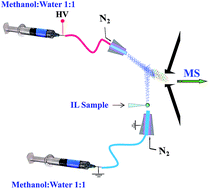Extractive electrospray ionization mass spectrometry of ionic liquids†
Abstract
The growing role of ionic liquids (ILs) in industry and research is creating an urgent need for the development of analytical methods for the reliable characterization and control of the composition of the ILs. The application of mass spectrometry (MS) to the analysis of ILs is limited by the poor tolerance of classical MS methods toward samples with high salt concentrations and viscosity. Herein, extractive electrospray ionization mass spectrometry (EESI-MS) was applied to directly analyze various room temperature ILs such as 1-butyl-3-methylimidazolium hexafluorophosphate ([Bmim][PF6]) 1-butyl-3-methylimidazolium tetrafluoroborate ([Bmim][BF4]), and 1-butylpyridinium tetrafluoroborate ([BuPy][BF4]). The EESI mass spectra of ILs diluted in methanol revealed great similarities to the mass spectra of the same samples assessed by direct infusion ESI-MS. Both cationic (C+) and anionic (A−) IL components could be detected with a high sensitivity from strongly diluted samples (<10−7 M). [CA − H]− or [CA + H]+ signals were observed for certain ILs using EESI-MS, and in good agreement with their classification based on the acid–base theory. With only minor alterations to the experimental setup, analysis of the ILs could be performed without dilution, which allowed a direct observation of the IL aggregates in the gas phase at a speed of >2 samples per min. EESI-MS allows the direct analysis of ILs in a broad concentration range with a high tolerance to chemical contamination. The reported examples suggest the potential for EESI-MS to interrogate large IL assays, which is critical in both fundamental physical chemistry studies and industrial applications.


 Please wait while we load your content...
Please wait while we load your content...